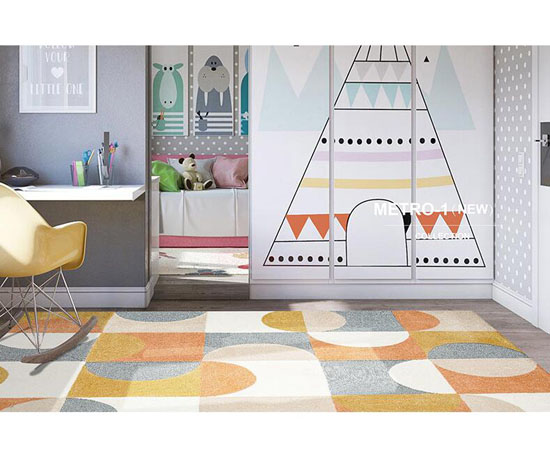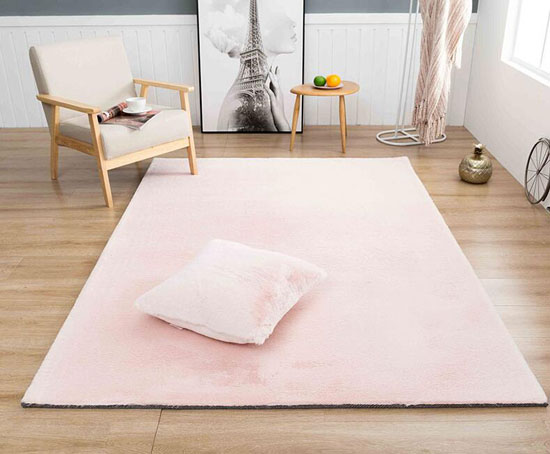A common misconception when it comes to interior design is that soft furnishings require less thought than larger pieces of furniture. The truth is that soft furnishings play an integral role in the most important tasks like layering and making a house feel like a home, and they should be chosen with as much care as any other piece for your interior.
Carpets, in particular, have long been a symbol of luxury, offering warmth and comfort underfoot, as well as color, texture and pattern. They can be used to divide a space, define a mood or simply display tapestry art on the floor.
But with the wide variety of piles, materials and styles available, making the investment isn't always easy. Whether you're after a slim hallway runner or a living room showpiece, our luxury rug buying guide offers ideas and advice on choosing the right rug for your home.

It's hard to imagine the true size of in-store and online rugs, so it's crucial to get the exact size of the rug you need and plan to display it in the area. To really make the most of a rug's design, it should always be surrounded by bare flooring or it will lose its effect to some degree, so plan a small space around the edge of the rug - perhaps a sidewalk. Your rug.
There are size guides to help you determine the size of the carpet you need, but remember that interior design should not be limited by hard and fast rules. Every space is different, and this approach should only be used as a starting point.
Kitchen and dining room rugs
For rugs in the kitchen or under the dining table, measure the circumference of the table and add approximately 140-150 cm to the length and width. This ensures that the rug is sized proportionally to the table and provides additional space for the chairs to remain on the rug when pulled out.
Bedroom rugs
In the master bedroom, add at least 60 cm to each side that does not touch the wall to ensure the carpet stays away from the bed frame. Comfort underfoot is the first thing in the morning - this size and positioning will ensure your feet touch the rug as you climb out of bed.
Living room rugs
As a rule of thumb for living room rugs that serve as furniture showcases, subtract approximately 60 cm from the length and width of the space to get the ideal rug size. If you are using a large rug, whether your furniture rests entirely on the rug or half on it is a personal preference. Play around with your room settings to see what works, but remember that if your rug has a nice pattern, it's best to show the full design.
Hallway Runners
For hallway runners, measure your space and subtract about 30 cm from the width and 60 cm from the length to get a neatly sized and perfectly dimensioned rug.

Next, consider the purpose of the carpet and the look you want to achieve, as this will help you determine the most appropriate type of carpet and carpet material. Carpets in high traffic areas need to be durable and easy to clean. In less populated areas of the home, such as the master bedroom or home office, you can try more adventurous and sophisticated fabrics.
Wool Carpet
Benefits
Wool carpets, along with other natural materials such as mohair and sheepskin, offer outstanding natural beauty and resilience. They are highly insulating and naturally resilient, which means they will retain their fresh look for years. The texture of wool allows it to recover quickly from crushing or indentations caused by footsteps or furniture, and because it is covered in natural lanolin, this material has better stain resistance than the best synthetic fibers. This coating helps stop dirt and stains from penetrating the fibers, leaving any stains on or near the surface, and makes spills easy to clean.
Disadvantages
Wool carpets are prone to fading if they are continuously exposed to direct sunlight. However, the process used to dye wool carpets helps improve fade resistance. The material is also highly absorbent and can easily become moldy if placed in a humid space. Because wool is the benchmark material for luxury carpets, its price point often reflects its incredible natural properties and the skill required to create the design.
Silk Carpet
Benefits
Silk carpets offer countless visual benefits; their fibers set the standard when it comes to high sheen and luster. For centuries, this material has been the material of choice for fine Persian and Oriental carpets, thanks to its tensile strength, which allows weavers to weave it into tight and intricate patterns. Silk fibers also respond well to the dyeing process and have the ability to hold color beautifully.
Disadvantages
Due to their delicate nature, silk rugs are better suited for low-traffic areas of the home. They tend to accumulate dirt and hooked silk, and are expensive and difficult to repair. Silk rugs are also expensive, but this reflects their longevity and the high level of expertise required to make them.
Cowhide Carpets
Benefits
As a natural by-product, cowhide rugs are known for their natural beauty. Each skin is unique in terms of color and pattern, which means that no two designs are alike. These rugs are soft but very durable and are also hypoallergenic. Because of their extreme durability, cowhide floor coverings can last for years and in some cases can last for life. They are easy to maintain and usually only require shaking with a damp sponge or spot cleaning.
Disadvantages
Cowhide rugs are susceptible to sun fading. While their natural features are worth celebrating, the unique irregular contours of cowhide rugs can make it difficult to fit into compact spaces and take up unexpected space.
Viscose rugs
The Benefits
Viscose fiber designs can be as beautiful as natural creations and offer a different type of durability. Their fibers have a lustrous appearance and a silky texture. They are hypoallergenic and resistant to pilling, insect damage and mildew. Usually lightweight, viscose carpets are known for their good drapability and ease of maintenance. For daily care, simply sweep or vacuum.
Disadvantages
Man-made materials tend to wrinkle and lose strength when wet, which means stains are difficult to wash out. Viscose fibers offer less natural bounce, and some designs may shed slightly.
Short pile carpet
Benefits
Short-pile rugs are extremely long-lasting and do not flatten easily under pressure, which makes them ideal for withstanding the movement of dining room chairs. These designs also allow for more intricate patterns to be woven into their short fibers. Low pile attracts less dust and hides wear and tear than deep pile designs.
Disadvantages
Short pile rugs exhibit a flat appearance where you can't see the individual fibers as you would on a long pile rug. This may mean that short-pile designs look less luxurious, but they are easier to care for than long-pile.
Long Pile Carpet
Benefits
Pile density can also greatly affect the performance of a rug. A fluffy, long pile can make a room more comfortable and rarely requires tidying. Of course, they exhibit textural depth due to their long and luxurious fibers.
Disadvantages
Long terry rugs are easy to hook, so they are not the best choice for children's bedrooms or homes with pets, but they are durable. They are not as suitable for high-traffic areas of the home as short-pile rugs.
Hand knotting is a very time consuming process and indicates superior quality. The technique is often used for fine oriental rugs and includes pile-head knots using cotton warp, wool or silk, and cotton weft inserted after every two rows of knots. Just as a high count means luxury bedding, a high knot count is a sign of excellence. Fine rugs can take months or even years to produce, have 400 or more knots per square inch, and allow for highly intricate patterns.
Hand-Tufted Carpets
This process is not as complex as knotting, but still provides an effective canvas for impressive designs. Because the process is not as labor-intensive as hand knotting, tufted designs are often more affordable. In addition, hand-tufted carpets offer durability and flexibility for superior designs.
✴ Apply cold water to any carpet stains and spills, as rubbing will make the stain worse. For aggressive stains or extremely expensive designs, always seek expert help.
✴ Coarse pile and terry rugs should be tapped to remove dust and dirt, while hand-spun yarn rugs should be vacuumed regularly first, as they often shed.
✴ Turn carpets regularly, as sunlight can cause fading. Beware that furniture and heavy foot traffic can flatten certain areas, resulting in an uneven appearance.
✴ Carpets placed on wood or tile surfaces should have padding to prevent slipping. Padding also improves underfoot comfort, extends the life of the carpet, prevents the transfer of natural vegetable dyes to the floor, and provides additional thermal and acoustic insulation.
Keep in mind that the padding should be slightly smaller than the carpet itself so that it does not show through from underneath.